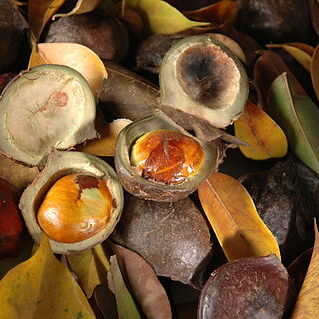Shrub or tree, to 21 m high, 60(-90) cm in diameter. Branchlets terete with decurrent ridges from the leaf-scars, light brown, glabrous. Leaves: petiole 2-7 cm, glabrous, gland(s) on petiole often present, circular in outline, sessile, subglobose to flat, 1.5-2 mm in diameter; pinnae 1 pair, to 20 cm, glabrous; petiolules 4-6 mm, glabrous; leaflets 2 or 3 pairs per pinna, opposite, drying ± dark greyish on both surfaces or green beneath, chartaceous, equal-or unequal-sided, ovate-elliptic to oblong, 5.5-20.5 by 2.4-7 cm, base ± asymmetrically rounded to broadly cuneate, apex obtusely acuminate, both surfaces glabrous; principal lateral veins c. 6-10 per leaflet-half, strongly arching, non-parallel; reticulation fine, inconspicuous or prominulous on both surfaces, more distinct beneath. Inflorescences either ramiflorous below the leaves or axillary at the distal leaves, with scattered hairs in the distal parts, glabrescent, consisting of glomerules aggregated into panicles to 30 cm long; glomerules or small spikes composed of 4-7 sessile flowers; floral bracts ovate or ovate-elliptic, acute, 0.5-1 mm, appressed-puberulous. Flowers cream or yellowish white, pentamerous, bisexual. Calyx broadly campanulate to cup-shaped, 1-2 mm, scarcely puberulous especially in the proximal part; teeth deltoid, acute, 0.2-0.3 mm. Corolla funnel-shaped, 4-5 mm, tube glabrous; lobes ovate-elliptic to oblong, acute, c. 2 mm, appressed-puberulous or glabrous at the apex, reflexed. Stamens c. 8-10 mm, tube equalling the corolla-tube. Ovary solitary, glabrous. Pod greyish to dark brown or dark purple outside, greyish within, falcate or twisted in a wide spiral or contorted into a circle c. 11 cm in diameter, ± deeply lobed between the seeds along the ventral suture, at maturity most often divided quite down to the thickened dorsal suture, the segments being separated by necks, pod woody, to 20-25 by 5.2 cm, glabrous, with inconspicuous veins, dehiscing along the ventral suture. Seeds dark-brown, orbicular, biconvex. 2.8-3.5 cm in diameter, 1-1.5 cm thick.
More
A shrub or tree. It can grow to 21 m high. The trunk can be 60 cm across. The branches are round but with ridges down the stem from the leaf scars. The leaf stalk is 2-7 cm long. The leaves are compound with one pair of primary branches and 2 or 3 pairs of leaflets along these. The leaflets are oval and 5.5-20.5 cm long by 2.4-7 cm wide. The flower clusters have 4-7 flowers on one long stalk. They are cream to white with 5 flower parts and both sexes. The fruit is a pod which is dark brown and twisted into a wide spiral or circle. This is about 11 cm across. The pod is deeply lobed between the seeds. The pod is woody and 20-25 cm long by 5 cm across. It opens along the centre. The seeds are dark brown and 3-3.5 cm across. They are 1-1.5 cm thick.

